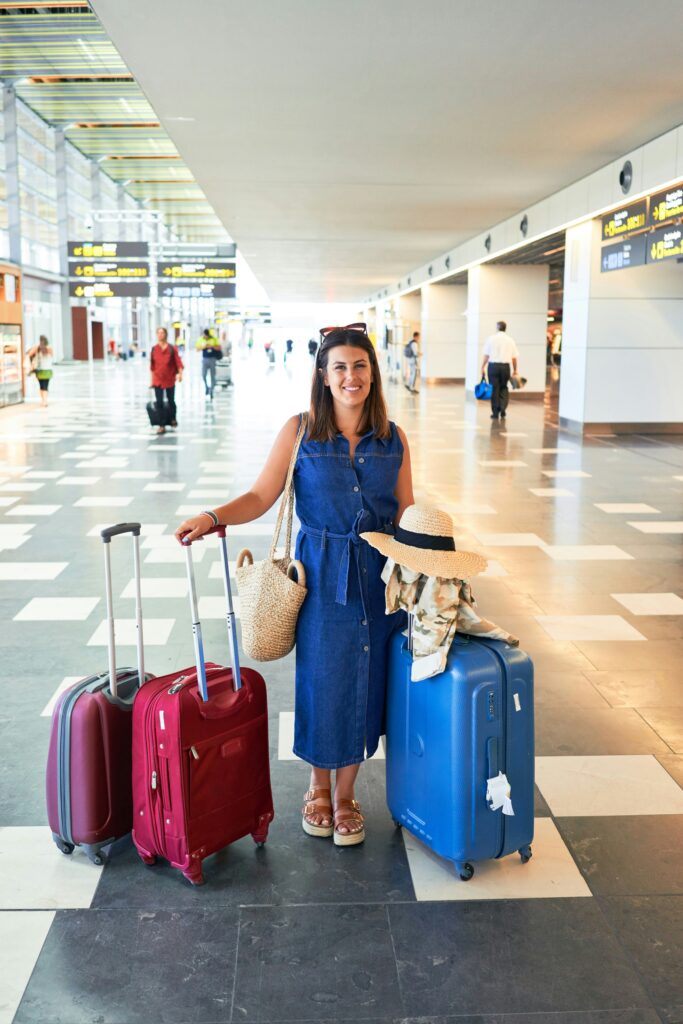A Guide to Understanding Airport Layouts, Security Procedures, and Check-In Processes
Flying for the first time can be both exciting and overwhelming. Airports are bustling hubs with various procedures, security protocols, and numerous signs, which can be confusing if you’re unfamiliar with them. However, understanding how airports work and what to expect will make your first journey much smoother. This guide will walk you through the essential aspects of navigating an airport, including airport layouts, security procedures, and check-in processes.

1. Understanding Airport Layouts
Airports, though varying in size and design, generally follow a similar structure that includes distinct areas for departure, arrival, and services.

Key Areas in an Airport:
- Departure Area: This is where you’ll start your journey. It includes the check-in counters, security checkpoint, and boarding gates.
- Arrival Area: This is where passengers arrive after their flight, typically including baggage claim, customs (for international flights), and exit points.
- Check-in Counters: Located in the departure area, these are used for checking in your luggage and obtaining your boarding pass if you haven’t done so online.
- Security Checkpoint: A controlled area where passengers and their belongings are screened for safety before proceeding to the boarding gates.
- Boarding Gates: These are located past the security checkpoint and are where you will board your flight. Gates are usually numbered and marked, so follow airport signs to your assigned gate.
- Baggage Claim: In the arrivals area, this is where you collect your checked baggage after the flight.
- Tips for Navigating Airport Layouts:
- Follow Signs: Airports are filled with clear, color-coded signs in multiple languages, usually pointing toward check-in, security, gates, and baggage claim. Pay attention to these signs for easy navigation.
- Maps: Most airports offer digital or paper maps at information desks. You can also download maps of major airports ahead of time through apps or the airport’s website.
- Ask for Assistance: If you feel unsure about where to go, airport staff are trained to assist passengers. Feel free to ask for help at any information desk.
2. The Check-In Process
The check-in process is the first step in your airport journey, where you confirm your presence on the flight, receive your boarding pass, and check your baggage if needed.

Types of Check-In:
- Online Check-In: Many airlines allow passengers to check in online up to 24-48 hours before the flight. You can print your boarding pass or save it on your phone to avoid long lines at the airport.
- Self-Service Kiosks: At the airport, many airlines have kiosks where you can check in by entering your flight details or scanning your passport. These kiosks also allow you to print your boarding pass and luggage tags.
- Counter Check-In: If you prefer checking in at the airport or need to check in baggage, visit your airline’s check-in counter. The staff will print your boarding pass and provide luggage tags for any checked bags.
- Baggage Check:
- Carry-On Baggage: If you’re only carrying a small bag that fits the airline’s dimensions, you can take it with you through security without checking it in.
- Checked Baggage: For larger items, you’ll need to check them in. The airline will weigh your bag and ensure it complies with baggage policies. After tagging your luggage, it will be sent to the aircraft’s cargo hold.

Important Documents:
Make sure you have the following documents ready:
- Passport (for international flights) or photo ID (for domestic flights)
- Boarding pass
- Flight itinerary
Tips for Check-In:
- Arrive Early: For domestic flights, arrive at least 2 hours before departure, and for international flights, 3 hours is ideal.
- Baggage Weight: Double-check the airline’s baggage policy to avoid extra fees for overweight luggage.
- Travel Light: If possible, pack light to avoid the hassle of checking in bags and waiting at baggage claim.
3. Going Through Security Procedures
Security screening ensures that all passengers and their belongings are safe for travel. This process is mandatory and often the most time-consuming part of your airport experience.

What to Expect at Security:
- Prepare Your Documents: Have your boarding pass and ID ready for inspection before entering the security area.
- Baggage Scanning: You’ll need to place your carry-on bags, electronics, and personal items in bins to be scanned by an X-ray machine. This includes removing laptops, tablets, and liquids from your bag.
- Liquid Restrictions: Liquids in your carry-on must be stored in containers of 100 ml or less, and they must all fit into a clear, resealable plastic bag (usually 1-liter size). This includes toiletries, cosmetics, and drinks.
- Remove Metal Items: Before walking through the metal detector, remove belts, jewelry, watches, and items from your pockets. Shoes may also need to be taken off, depending on the airport’s security protocols.
- Body Scanners: After placing your items on the conveyor belt, you’ll walk through a metal detector or full-body scanner.
Tips for Speeding Up Security:
- Prepare in Advance: Before reaching the security line, make sure your liquids are in a clear plastic bag and that you have removed laptops or electronics from your bag.
- Wear Slip-On Shoes: It makes removing and putting on shoes easier if required.
- Limit Jewelry and Metal: Remove these items before reaching the checkpoint to avoid triggering the detectors.
- Follow Instructions: Listen to the security personnel’s instructions, as different airports may have slightly different procedures.
4. Boarding Your Flight
Once you’ve cleared security, you’ll head to your boarding gate. Boarding gates are typically located in concourses or terminals and are clearly numbered.

What to Expect at the Gate:
- Wait for Boarding: Check the screens at your gate for updated flight information. Boarding usually starts 30 to 45 minutes before departure.
- Boarding Pass: When your flight is called, the gate agents will scan your boarding pass. Make sure you have it ready, either printed or on your phone.
- Board by Groups: Airlines often board passengers in groups based on ticket class, frequent flyer status, or seat location. Listen for your group’s announcement.
Tips for Boarding:
- Stay Near the Gate: Keep an eye on boarding announcements and be ready when your group is called.
- Double-Check Your Seat Assignment: Confirm your seat on your boarding pass to avoid confusion once onboard.
5. Baggage Claim and Exiting the Airport
After landing, you’ll proceed to baggage claim (for checked luggage) and then exit the airport.

What to Expect After Landing:
- Customs and Immigration: If you’re flying internationally, you’ll go through customs and immigration to declare any goods and present your passport.
- Baggage Claim: Follow signs to the baggage claim area and wait at the carousel for your bags. The carousel number for your flight will be displayed on nearby screens.
Tips for Exiting the Airport:
- Keep Track of Your Luggage: Double-check that you collect all your bags before leaving.
- Plan Transportation: Whether you’re taking a taxi, rideshare, or using public transportation, plan your ride ahead of time. Many airports have signs guiding you to the correct pick-up locations.
Conclusion
Navigating an airport doesn’t have to be daunting, especially when you understand the layout, check-in procedures, security processes, and boarding practices. With some preparation and these handy tips, you’ll be able to confidently make your way through any airport with ease. For first-time flyers, arriving early, staying organized, and following instructions can make all the difference in having a smooth and stress-free journey.
Safe travels and enjoy your flight!
